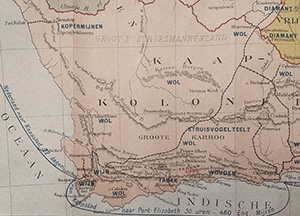 The harbour of Cape Town is South Africa’s second port after Durban. The old and beautiful port city attracts many tourists and also foreign companies involved in industry, finance, trade and shipping.
The harbour of Cape Town is South Africa’s second port after Durban. The old and beautiful port city attracts many tourists and also foreign companies involved in industry, finance, trade and shipping.
After seafarers from the Middle East had passed the southern tip of Africa centuries earlier, the Portuguese were the first Europeans to round the cape at the end of the fifteenth century. Bartholomeus Diaz called it “Cape of Storms” because of the raging of violent storms. That menacing name was changed into “Cape of Good Hope”.
In 1652, the Dutchman Jan van Riebeeck set foot with five ships and seventy men on the spot where Cape Town is now located The Dutch East India Company (VOC) asked him to establish a supply station there, because during the long sea voyage between the Netherlands and the Dutch East Indies, the sailors suffered serious illnesses, especially scurvy, due to a lack of fresh food. Van Riebeeck had vegetable gardens laid out, a fort built and a piece of land fenced in to build houses. There was much struggle with the indigenous people, the Khoikoi, who stood up for their freedom and their livestock, which was taken by the colonists.
In the course of time, VOC men and immigrants, such as French Huguenots and German sailors who often married orphaned girls, founded farms in the surrounding area; these free citizens or Afrikaners colonised more and more areas. The Khoikoi lost their land and were destroyed by smallpox. Because there were not enough workers, some 60,000 slaves were brought from Africa and Southeast Asia to work on the farms and for the residents of emerging Cape Town. Around 1730, 40 percent of the city’s population consisted of slaves.
In the twentieth century, the slave society transitioned into the Apartheid regime, with a small, white upper class and an oppressed black population. At the end of the twentieth century, internal and external pressure on the white South African government had become so great that free elections were held. Charismatic African National Congress leader Nelson Mandela, who had been imprisoned for nearly three decades, became the first black president in 1994. There was no end to the poverty and inequality in the country during his reign and the governments after him.
Cape Town’s harbour was a pivotal point in international trade between Europe and Asia for several centuries, until the opening of the Suez Canal in Egypt in 1869, which cut sailing time. Cape Town lost its function as a provision port, but became a hub for trade in grain, wool, fruit, wine and fish. From 1860 onwards, several harbour basins were built, which, as is the case in many old ports, have now been transformed into a tourist waterfront.
Two new main docks were built in the sea. In one of them is a container terminal; in the other are fruit and multi-purpose terminals. The terminals are well connected to the African hinterland via a railway network and major roads.
Cape Town and Western Cape are the gateway to Africa. The African population is expected to increase from over 1 billion to 2.4 billion in 2050. This means a growing market for South African and foreign businesses. Exports from Cape Town, such as fruit, fish, artificial fertilizer, soy, wheat, corn and cement, now mainly go to Africa (43%), Europe (24%) and Asia (16%). China is the most important trading partner in terms of imports into Cape Town.




